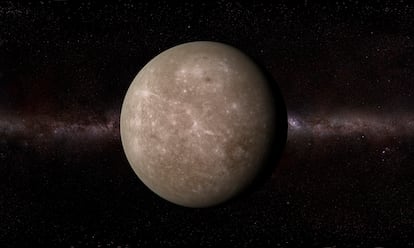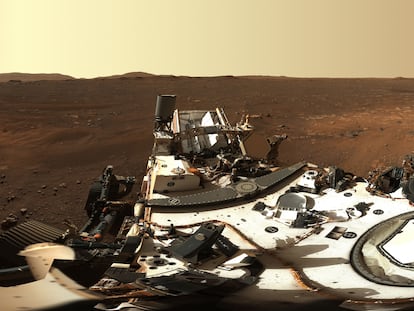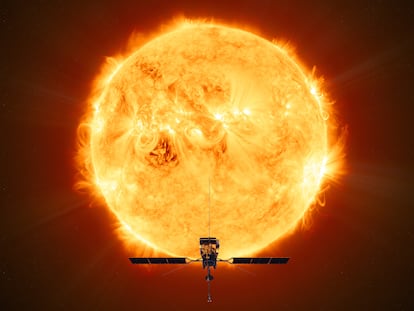What’s so special about our solar system’s smallest planet?
An otherworldly place of untouched craters, unique sunsets, extreme temperatures and a magnetic field that’s hard to understand is right next door, yet we know very little about it

Imagine a planet without seasons, where two years pass in three days and light never reaches the poles; where surface temperatures are high enough to melt lead and low enough to freeze methane. But above all, imagine what it would be like to contemplate a sunset in which the Sun plunges into the horizon to go backwards a moment later, as if someone had pressed the rewind button, and a day or two later disappear in the western twilight.
That strange planet is right next door and is called Mercury. Mercury travels around the Sun faster than any other object in the solar system, completing a full orbit every 88 days. It is very bright in the sky, but because of its proximity to the Sun it is very difficult to study, so we don’t know an awful lot about it.
As it moves fast in the sky and is small, the planet was associated in ancient Greece with the role of the go-between that put one god in contact with another. Mercury takes its name from the Roman god of shopkeepers and merchants, thieves and tricksters. It is related to the Egyptian god Thoth and the Nordic god Odin and also occupied a prominent place in Mayan culture as a celestial object. All this mythological relevance in various cultures highlights something very simple: it is a prominent object in the night sky.
The planet rotates very slowly, which is why its days and nights are so long; one day on Mercury is equivalent to 58.6 Earth days. Its year, which lasts 88 Earth days, is very short as it is the closest planet to the Sun. Its rotation period is not synchronized with its orbital period, as happens in the case of the Moon, but both periods are similar, in what we know as a 3:2 resonant orbit. This means that for each revolution around the Sun — the orbital period — Mercury rotates one and a half times around its axis; and that in two complete orbits around the Sun the planet rotates three times on its axis. One side of the planet is not always facing the Sun and the other in complete darkness, however, the alternating periods of darkness and light are very long.
Mercury moves with a rather elongated orbit at an average distance of 57.9 million kilometers around the Sun. According to Kepler’s second law, in such an elliptical orbit the planet’s velocity changes greatly at its most extreme points. Therefore, when Mercury is at perihelion — the closest point of its orbit to the Sun — it moves at a speed of 59 kilometers per second (note that the Earth moves at 30 kilometers per second). Remember that it was precisely the measurement of the advance of Mercury’s perihelion explained in terms of space-time curvature that was one of the key elements used to prove the theory of general relativity.
On Mercury’s surface, the Sun rises in the east and sets in the west, as it does on Earth. But once a year, when it passes through the perihelion, the orbital motion overtakes the slow rotation of the planet and on that day the Sun’s path is interrupted. It is at that point in its orbit that the strange sunsets can be contemplated. The star comes to a complete stop in the Mercurian sky and moves backwards to return to its normal path as the planet’s speed decreases and it moves in its orbit.
Because Mercury is closer to the Sun, the light reaching its surface is seven times more intense than on Earth. And that light has about three months to heat its surface. The planet rotates very slowly and as a consequence, temperatures on its surface are high enough — no less than 420ºC — to melt lead. Similarly, the time from when the Sun sets until it rises again is approximately three Earth months. Three months in complete darkness to cool the surface of the planet to nighttime temperatures that drop below -170ºC, cold enough to freeze methane and carbon dioxide.
Mercury has no seasons because it rotates on its axis almost perpendicular to its orbit, which also means that in its polar regions the interiors of its large craters are permanently in shadow. One of the great mysteries that the BepiColombo probe will try to solve is whether these craters contain sulfur or ice.
The little planet Mercury has a magnetic field similar to ours, only with 1% of its strength, and is unique among the rocky planets in our solar system because, like Earth, it has a self-sustaining magnetic field. Why Earth and Mercury maintain a magnetic field and Venus, Mars and the Moon do not is something we do not yet understand.
Mercury still holds mysteries that the joint mission of the European Space Agency (ESA) and the Japan Aerospace Exploration Agency (JAXA) BepiColombo are trying to solve. It has only been visited twice, with the Mariner 10 and Messenger probes.
BepiColombo will be the third probe on this unique, small, mysterious and difficult-to-explore planet that has helped us lay the foundations of current physics and will surely give us fundamental clues to the evolutionary history of our solar system and the formation of the Earth.
Sign up for our weekly newsletter to get more English-language news coverage from EL PAÍS USA Edition










































